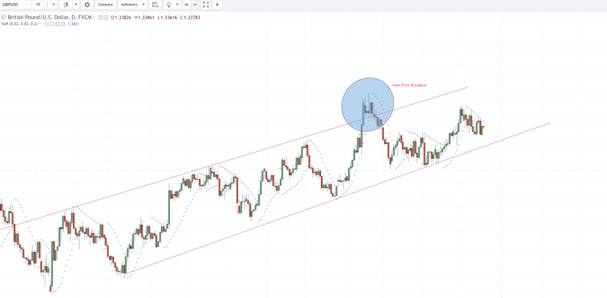A currency movement fake-out, or a fake price breakout above or below a support or resistance level, is the bane of professional and amateur traders alike. They are just so hard to spot and difficult to remedy. The scenario usually goessomething like this: you’ve done your homework, you believe that the price is highly overvalued and think it should drop substantially, you’ve patiently waited for the price to fall below a long-held level for about 2 months, it finally does triggering your stop order… but then as if tripped up by a head fake on a basketball court, the price almost immediately pops right back up again taking your position way into the red.
Well, prevention is better than cure so the best strategy to avoid these situations is to wait until the price falls convincingly above or below a level. Never place an at-market order. Place a stop ‘buy’ or a stop ‘sell’ order to prevent yourself making impulsive trades, it’s important to remain disciplined.
The second strategy is (if for example, talking about a shorting order) to wait until the price settles at a level below the support and then put in a sell stop order below that. Often, the price or market will ‘think’ about the new price reality once a support or resistance level is broken and then continue its way down (or bounce back up if there is no further selling pressure). Place a sell-stop order a good 10 or 20 pips away from a support level, just in case it’s been miscalculated and placed incorrectly on the chart and even then, only allocate a small percentage of your equity to the position.Always assume there’s very good chance you’ve got it wrong.
Another important way to assess whether the break of a support or resistance level is genuine is to monitor appropriate technical indicators. For example, if there is divergence in an oscillator technical indicator signalling that there is upwards buying pressure, but the impervious pricefalls below a resistance line, it’s best to have your ducks lined up in row and hold fire. This approach is the same for fundamental analysis. If there is no real motivation for a price to fall below significant support (i.e. data release or geopolitical event), but it has been broken nonetheless, then again, it’s best to hold fire. If you have decided to enter a position, as mentioned, it’s best to wait until the price persuasively falls below a level. This means waiting until the next period (on the daily chart) or even the period after the next to confirm that the price is indeed following a new path.
If an order has already been triggered following a price spike down or up, stop losses are vital for cutting losses if the price rebounds in the opposite direction. If no stop loss has been added to the position, then a manual closing of the position is absolutely necessary. It will be difficult to accept the loss and to recognise the mistake, but a stop loss situated at the broken support or resistance level is the best policy. It’s best to recognise this fake-out problem as soon as possible as quickly retracing price behaviour can quickly become painful. Remember, every losing trade has a silver lining if you can learn from the error of judgement.
The below chart is an example of a GBP/USD misleading price breakout that lacks momentum to push higher. Notice the price falls in the period after the breakout.
All essays, research and information found above represent the analysis and opinion of Leverate only. As such it may prove wrong and be a subject to change without notice. Opinions and analysis were based on data available to the author of the respective essays at the time of writing. Although the information provided above is based on careful research and sources that are believed to be accurate, Leverate does not guarantee the accuracy or thoroughness of the data or information reported. The opinions published above are neither an offer nor a recommendation to purchase or sell any securities. Leverate is not a Registered Securities Advisor. By reading Leverate’s reports you fully agree that they will not be held responsible or liable for any decisions you make regarding any information provided in these reports. Investment trading and speculation in any financial markets may involve risk of loss.e risk of loss.
Editors’ Picks

EUR/USD rebounds after falling toward 1.1700
EUR/USD gains traction and trades above 1.1730 in the American session, looking to end the week virtually unchanged. The bullish opening in Wall Street makes it difficult for the US Dollar to preserve its recovery momentum and helps the pair rebound heading into the weekend.

USD/JPY rallies to near 157.00 as Yen plunges after BoJ’s policy outcome
The USD/JPY is up 0.85% to near 156.90 during the European trading session. The pair surges as the Japanese Yen underperforms across the board, following the Bank of Japan monetary policy announcement. In the policy meeting, the BoJ raised interest rates by 25 bps to 0.75%, as expected, the highest level seen in three decades.

Gold stays below $4,350, looks to post small weekly gains
Gold struggles to gather recovery momentum and stays below $4,350 in the second half of the day on Friday, as the benchmark 10-year US Treasury bond yield edges higher. Nevertheless, the precious metal remains on track to end the week with modest gains as markets gear up for the holiday season.

Crypto Today: Bitcoin, Ethereum, XRP rebound amid bearish market conditions
Bitcoin (BTC) is edging higher, trading above $88,000 at the time of writing on Monday. Altcoins, including Ethereum (ETH) and Ripple (XRP), are following in BTC’s footsteps, experiencing relief rebounds following a volatile week.

How much can one month of soft inflation change the Fed’s mind?
One month of softer inflation data is rarely enough to shift Federal Reserve policy on its own, but in a market highly sensitive to every data point, even a single reading can reshape expectations. November’s inflation report offered a welcome sign of cooling price pressures.
RECOMMENDED LESSONS
Making money in forex is easy if you know how the bankers trade!
I’m often mystified in my educational forex articles why so many traders struggle to make consistent money out of forex trading. The answer has more to do with what they don’t know than what they do know. After working in investment banks for 20 years many of which were as a Chief trader its second knowledge how to extract cash out of the market.
5 Forex News Events You Need To Know
In the fast moving world of currency markets where huge moves can seemingly come from nowhere, it is extremely important for new traders to learn about the various economic indicators and forex news events and releases that shape the markets. Indeed, quickly getting a handle on which data to look out for, what it means, and how to trade it can see new traders quickly become far more profitable and sets up the road to long term success.
Top 10 Chart Patterns Every Trader Should Know
Chart patterns are one of the most effective trading tools for a trader. They are pure price-action, and form on the basis of underlying buying and selling pressure. Chart patterns have a proven track-record, and traders use them to identify continuation or reversal signals, to open positions and identify price targets.
7 Ways to Avoid Forex Scams
The forex industry is recently seeing more and more scams. Here are 7 ways to avoid losing your money in such scams: Forex scams are becoming frequent. Michael Greenberg reports on luxurious expenses, including a submarine bought from the money taken from forex traders. Here’s another report of a forex fraud. So, how can we avoid falling in such forex scams?
What Are the 10 Fatal Mistakes Traders Make
Trading is exciting. Trading is hard. Trading is extremely hard. Some say that it takes more than 10,000 hours to master. Others believe that trading is the way to quick riches. They might be both wrong. What is important to know that no matter how experienced you are, mistakes will be part of the trading process.
The challenge: Timing the market and trader psychology
Successful trading often comes down to timing – entering and exiting trades at the right moments. Yet timing the market is notoriously difficult, largely because human psychology can derail even the best plans. Two powerful emotions in particular – fear and greed – tend to drive trading decisions off course.

